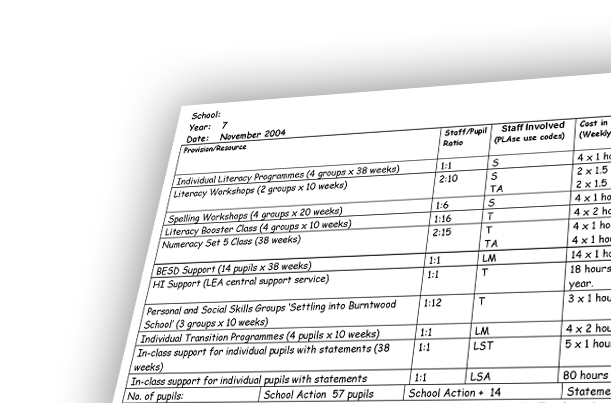
Targeted interventions and provision mapping
This unit examines the provision you can make to meet the needs of pupils with severe and complex SLCN. It describes the processes involved in mapping and monitoring the additional provision that your school makes for pupils with SLCN.
The unit covers:
- Specific interventions for individual pupils
- The characteristics of an effective intervention
- Research into the outcomes of Wave 3 interventions
- Provision mapping
Wave 3 interventions
Direct Wave 3 interventions involve specialists, such as speech and language therapists (SALTs), working directly with pupils to address their SLCN.
While this approach gives the pupil(s) the benefit of optimum specialist input, it is an expensive form of intervention. Additionally, because SALTs are in high demand, a direct intervention can only be made available to a small percentage of pupils for a small proportion of time.
Interventions for severe or complex SLCN should be
- Systematic
- Explicit
- Intense
- Monitored
Provision mapping
A provision map is:
- A strategic management tool.
- A way of describing all provision that a school offers its pupils – including that which is "additional to and different from".
- A tool with which to audit needs and plan provision that will meet those needs.
- A means to evaluate the effectiveness of provision.
- Something that can support communication with staff, parents and governors.

Creating a provision map for pupils with SLCN
If your school doesn't have a provision map, it is possible to create one that focuses just on the one group of pupils.
Follow the steps laid out here to review and plan provision for pupils with SLCN in your school.
- 1. Identify existing provision
- 2. Analyse future requirements
- 3. Compare
- 4. Review research
- 5. Plan provision
- 6. Assess and evaluate
1. Identify existing provision
It is important that you have a complete picture of what provision is currently made for pupils with SLCN in your school. You should identify:
- The provision offered
- The staff:pupil ratio
- Which staff are involved in delivery
- The frequency and duration of provision
Organise the information you collect according to class or year group.
« Return2. Analyse future requirements
Analyse pupil achievement data for the group to establish what their individual needs are. Identify what provision will be required over the next term or academic year to meet these needs.
You will have to identify the cost of this provision. To do this, calculate the staff:pupil ratio, which staff will need to be involved, and the approximate weekly cost in time.
Prioritise these needs into:
- Essential
- Desirable
- Optional
3. Compare
You should review the projected needs that you have identified against the existing provision in your school. Identify any gaps, imbalances or potential issues. For example:
- Are there instances of under- or over-provision?
- Are there any problems with staff development which will need to be addressed?
4. Review research
Review research evidence to identify what works best for pupils with SLCN in terms of increasing their progress and achievement.
Look especially for research and information that indicates what works best for schools that are similar to your own. You can achieve this through discussions at cluster level and also by talking to SLC professionals who may have observed good practice in other school contexts.
« Return5. Plan provision
Based on your projections of need and your research into what works best, plan the provision map for the next term or academic year. You will need to consider the resource available against the prioritisation of need you identified in step 2.
« Return6. Assess and evaluate
Think about how you will measure progress in relation to each aspect of provision. You will need to capture entry and exit data in order to assess the impact of any recommended provision.
To do this, draw upon systems that are already in place in your school to monitor and track progress.
You should also think about:
- When you will monitor and review interventions
- What the success criteria will be for each aspect of provision
Then evaluate the impact of provision. The outcomes of this review will enable you to revisit and amend your provision map.
It is good practice to review and adapt provision maps each term, and to thoroughly review them once every academic year.
« Return